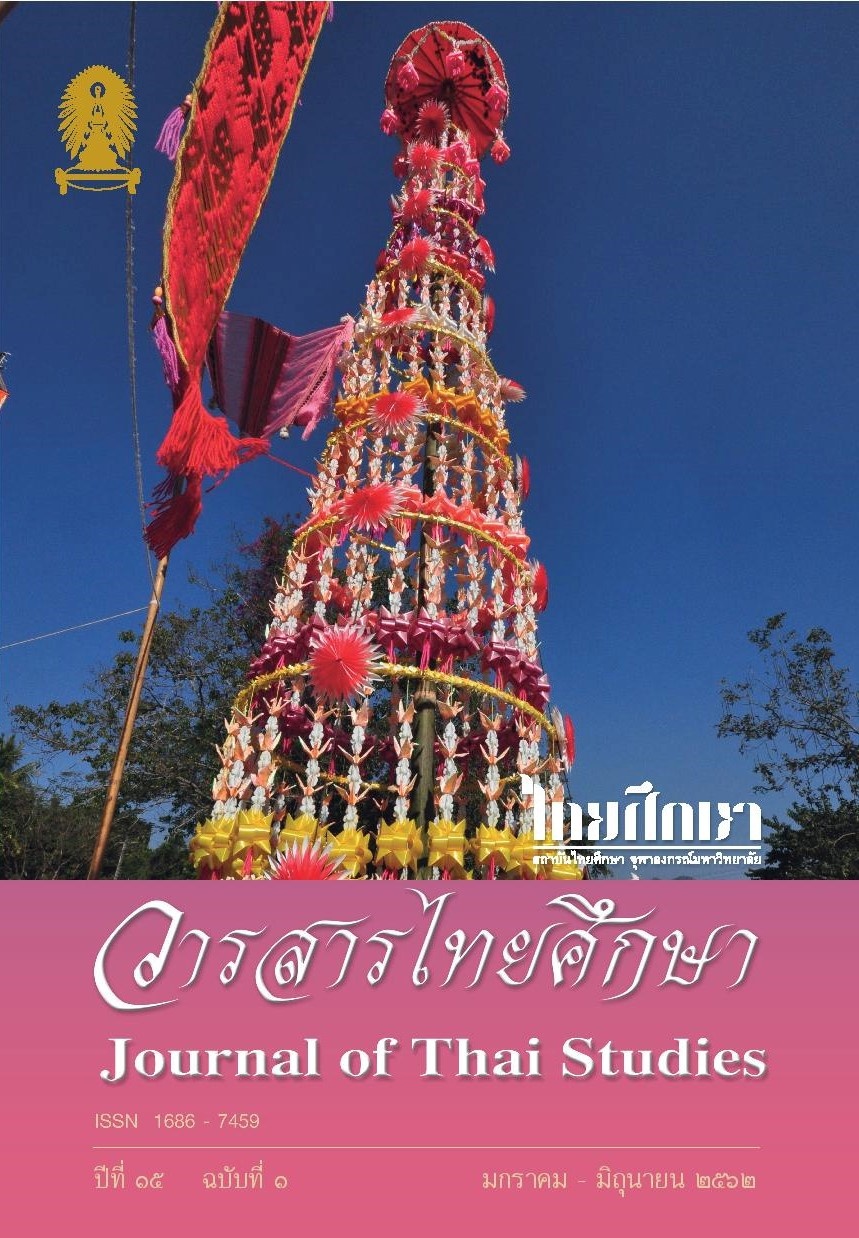The Play “Ngo Pa”: From Folklore to Literature
Main Article Content
Abstract
The article aims at exploring information regarding folklore and at analyzing the application of folklore in “Ngo Pa,” a play composed by King Chulalongkorn (King Rama V). It was found that information on various aspects of Koy people and their beliefs is portrayed throughout the play Ngo Pa, particularly in a short prelude at the beginning of the play. It is evident that information was deliberately asserted in various parts of the play. Furthermore, Koy people’s folklore is shown in relation to every literature element, including the main conflict caused by Koy’s belief in married life. Koy people’s folklore regarding clothes, weapons, lifestyles and beliefs mentioned in the first part of the play is also reflected through characters and forest setting with the vivid hint of the locals. It cannot be denied that the most important scene is the marriage scene, which conveys every aspect of Koy people’s folklore. These elements lead to the theme of powerful love between the main characters, an international theme highlighting the fact that these people are humans just like other groups of people. Regarding performance, Koy people’s status results in new and different patterns and content compared to traditional Thai plays. Music and clothing are furthermore adapted to correspond with the portrayal of the Koy people. In conclusion, information regarding folklore is considered important for this literature based on facts.
Downloads
Article Details

This work is licensed under a Creative Commons Attribution-NonCommercial-NoDerivatives 4.0 International License.
Journal of Thai studies is licensed under a Creative Commons Attribution-Noncommercial-NoDerivatives4.0 Intenational (CC BY-NC-ND 4.0) licence, unless otherwise stated. Plese read our Policies page for more information on Open Access, copyright and permissions.
References
Chulalongkorn (Rama V), H.M.K. (2016).Bot lakon rueang Ngo Pa chabap sopchamra prom tonchabap laiphrahat HRH Princess Nipanopadol [The play, Ngo Pa -official edition with the hand-written manuscript of HRH Princess Nipanopadol]. (2nd ed.). Bangkok: Saengdao.
Chongstitvatana, S. (2003). Kansueksa Phraratchaniphon Nai Thana Wannakhadi Kham Son [A study of royal compositions used in teaching literature.] In Piyarachakawin (pp. 23-40). Bangkok: Center of Research in Thai Language and Literature and Department of Thai, Faculty of Arts Chulalongkorn University.
Dorsch, T.S. (1965). Classical Literary Criticism. Baltimore: Penguin.
Duangchan, P. (1998). Phumlang Ngo Pa Sakai [History of the Sakai tribe]. In Sarup phol kan sammana thang wichakarn radub chat rueang Ngo pa [Summary of national academic seminar regarding Ngo pa]. (pp.85-94). Bangkok: literature and history Section, Department of Fine Arts.
Kiranandana, A. (2003). Phra At Riya Phap Thang Dan Wannakhadi Kan Sadaeng Thi Prakot Nai Phraratchaniphon Phrabatsomdet Phrachunlachomklaochaoyuhua [Excellence of King Rama V’s performance pieces that appear in his literary works]. In Piyarachakawin (pp. 97-113). Bangkok: Center of Research in Thai Language and Literature and Department of Thai, Faculty of Arts, Chulalongkorn University.
Nathalang, S. (2009). Tritsadi katichonwittaya: withi nai kan wikro tumnan puenban [Folklore theory: analysis methodology of myths and folk tales]. (2nd ed.). Bangkok: Chulalongkorn University Press.
Pukbhasuk, P. (2003.) Phasa nai pleng phra ratchanipon [Language used in royal musical compositions]. In Piyarachakawin (pp. 23-40). Bangkok: Center of Research in Thai Language and Literature and Department of Thai, Faculty of Arts Chulalongkorn University.
Pupaka, A. (2010). The works of King Chulalongkorn and King Vajiravudh: literature and nation-building. (PhD dissertation) Chulalongkorn University, Bangkok, Thailand.
Rueangraklikhit, C. (2016). Kanop wannakadi Thai in Phraratchanipon rueang Kapherua Nitanchakrit lae Ngo Pa [Tradition of Thai Literature in the royal barge chants, Nitanchakrit and Ngo Pa]. In Wannawichai (2nd ed., pp.64-126). Bangkok: Dissemination of academic work project, Faculty of Arts Chulalongkorn University.
Sangtaksin, Y. (2008). Ngo Pa: Wannakadi heng ratchasamai [Ngo Pa: A representative work of the reign]. Bangkok: Business Organization of the Office of the Welfare Promotion Commission of Teachers and Educational.
Sikkhakosol, T. (2016). Pleng thai in bot lakon rueang Ngo Pa [Thai songs in the play Ngo Pa]. In Chulalongkorn (Rama V), H.M.K. Bot lakon rueang Ngo Pa chabap sopchamra prom tonchabap laiphrahat HRH Princess Nipanopadol [The play Ngo Pa, official edition with the hand-written manuscript of HRH Princess Nipanopadol] (2nd ed., pp.37-46). Bangkok: Saengdao.
Sujachaya, S. (2003). Phrabat Somdet Phra Chulachomklao Chaoyuhua nai thana nak katichon. [King Rama V, an expert in folklore]. In Piyarachakawin (pp.115-129). Bangkok: Center of Research in Thai Language and Literature and Department of Thai, Faculty of Arts Chulalongkorn University.
Sujachaya S. (2013). Wannakam mukkapatha [Oral Literature]. Bangkok: Dissemination of academic work project, Faculty of Arts, Chulalongkorn University.
Tailanga, S. (2017). Sat lae sin khong kan lao rueang [Narratology]. (3rd ed.). Bangkok: Dissemination of academic work project, Faculty of Humanities, Kasetsart University.
The Royal Institute of Thailand. (2002). Potchananukrom sap wannakam English-Thai [Dictionary of English-Thai literature]. Bangkok: The Royal Institute of Thailand.
Thiapthiam, S. (1977). The play Ngo Pa by King Rama V: an analytical study of society and culture. (Master’s thesis). Department of Thai, Chulalongkorn University, Thailand.
Wingwon, S. (2012). Wannakadi Kansadaeng[Performance literature]. (2nd ed.). Bangkok: Department of Literature, Faculty of Humanities, Kasetsart University.


